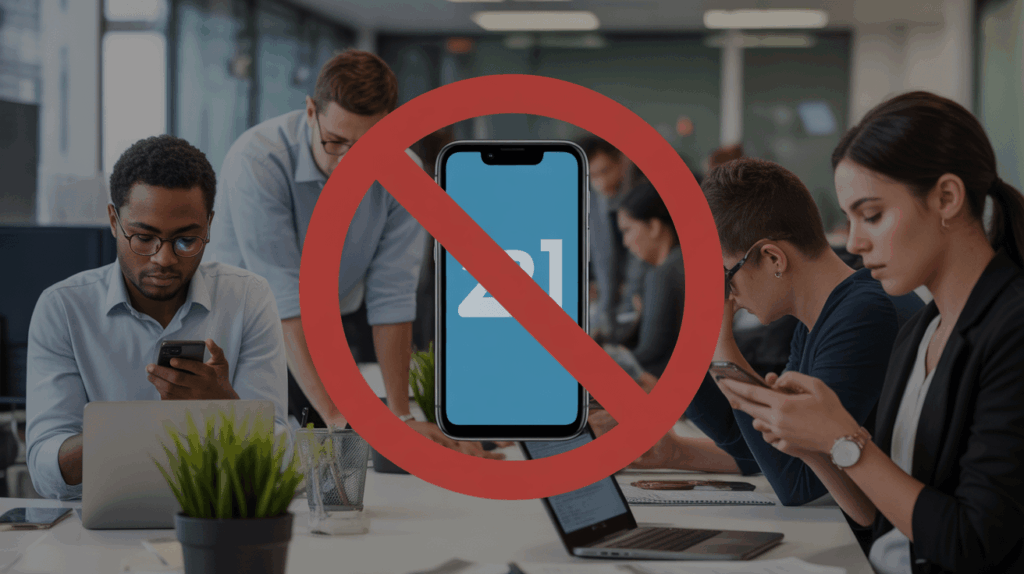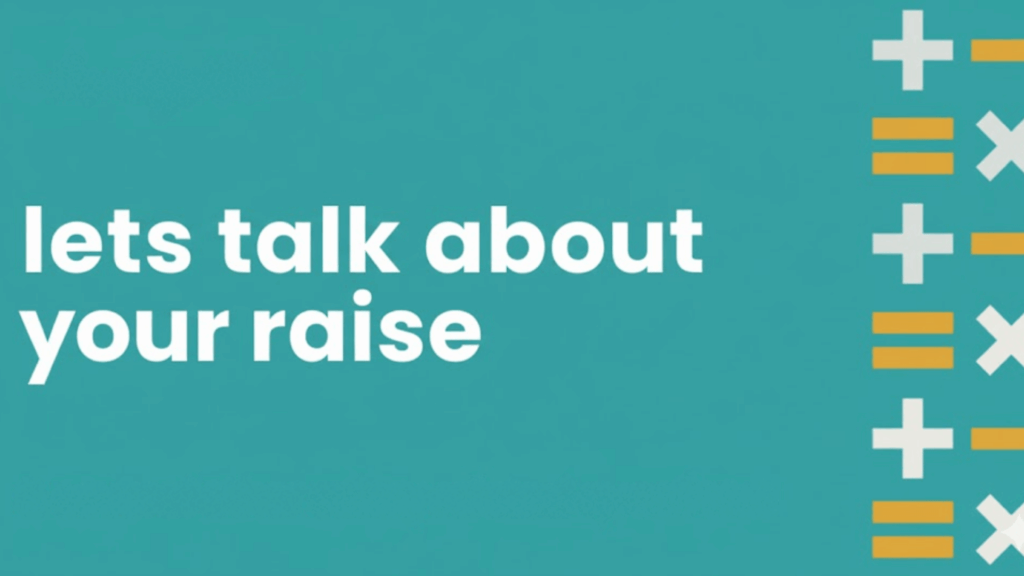Office workers check their phones over 150 times daily.
This costs companies millions in lost productivity each year.
Unmanaged phone use leads to missed deadlines, data security risks, and disrupted meetings.
A well-designed cell phone policy at work solves these problems effectively.
This blog post provides ready-to-use templates and real examples from successful companies.
You’ll learn step-by-step methods to create rules that protect your business while keeping employees satisfied.
Get everything needed to implement a policy that works for everyone.
Also read: How to Write a Cover Letter for Part-Time Jobs?
Why a Business Needs a Cell Phone Policy?
A cell phone policy at work is a set of clear guidelines that define acceptable use of personal and company-issued phones.
It ensures productivity, security, and professionalism by outlining when phones can be used, restrictions on apps, and handling of confidential data.
Without such rules, businesses risk productivity loss, employees take 23 minutes to refocus after interruptions, and there are data breaches, compliance issues, and meeting disruptions.
Since 78% of employees want clarity, a policy helps promote focus, protect information, and maintain workplace standards.
Key Components of an Effective Cell Phone Policy
Every good cell phone policy needs specific parts to work well.
These components help protect your business while keeping employees happy.
Use this table to make sure your policy covers all the important areas.
| Component | What to Include |
|---|---|
| Scope | Who the policy applies to |
| Acceptable Use | When phones can be used |
| Prohibited Use | What’s not allowed |
| Security Rules | Password and app restrictions |
| Emergencies | When rules don’t apply |
| Consequences | Penalties for violations |
Ready-to-Use Cell Phone Policy Templates
Building a cell phone policy from scratch takes time and effort. These tested templates and real-world examples speed up your process.
Pick the right template for your company size and start customizing today
Small Business Template (1-20 Employees)
Perfect for startups, family businesses, and local shops that need simple rules without complex procedures.
COMPANY’S CELL PHONE POLICYCompany: [Your Company Name] 1. WHO THIS APPLIES TO All employees, part-time staff, and contractors. 2. WHEN YOU CAN USE PERSONAL PHONES
3. WHAT’S NOT ALLOWED
4. SECURITY RULES
5. EMERGENCIES Medical emergencies and safety threats are exceptions. Notify supervisor immediately. 6. CONSEQUENCES First time: Verbal warning | Second time: Written warning | Third time: Performance review |
Medium Business Template (21-100 Employees)
Designed for growing companies with multiple departments that need structured policies but flexibility for different roles.
[COMPANY NAME] CELL PHONE POLICYCompany: [Company Name] Date: [Date] Version: 2.0 1. WHO THIS COVERS: 2. ACCEPTABLE USE: Company phones: Business calls, work apps, travel navigation only 3. PROHIBITED ACTIVITIES
4. SECURITY REQUIREMENTS
5. DEPARTMENT RULES Sales: Client calls OK, personal calls during downtime 6. EMERGENCIES 7. CONSEQUENCES |
Enterprise Template (100+ Employees)
Built for large organizations requiring detailed compliance, advanced security, and legal protection across multiple locations.
ENTERPRISE CELL PHONE POLICYCompany: [Company Name] Date: [Date] Version: 3.0 1. SCOPE All personnel across all locations: employees, contractors, vendors, and board members. Devices: Company phones, personal devices, wearables, IoT devices. 2. BUSINESS USE ONLY
3. STRICTLY PROHIBITED
4. ENTERPRISE SECURITY
5. COMPLIANCE REQUIREMENTSGDPR/CCPA: Data privacy protocols mandatory HIPAA: Healthcare divisions follow medical privacy rules SOX: Financial data restrictions apply 6. EMERGENCY EXCEPTIONS Life-threatening emergencies, natural disasters, security breaches, system outages 7. VIOLATION MATRIX Minor (Personal use): Verbal → Written → Performance plan Severe (Security breach): Final warning → Suspension → Termination Critical (Data breach): Immediate investigation → Termination consideration 8. GOVERNANCE Annual policy review by Legal, IT Security, and HR. Quarterly regulatory updates. |
Visual Examples of Cell Phone Policy Implementation
Clear signage helps employees stay aligned with workplace cell phone rules and maintain productivity.
Download five free, ready-to-use cell phone policy templates to keep your workplace focused and compliant.
1. Cell Phone Policy – Restrict Phone Use in Operational Areas
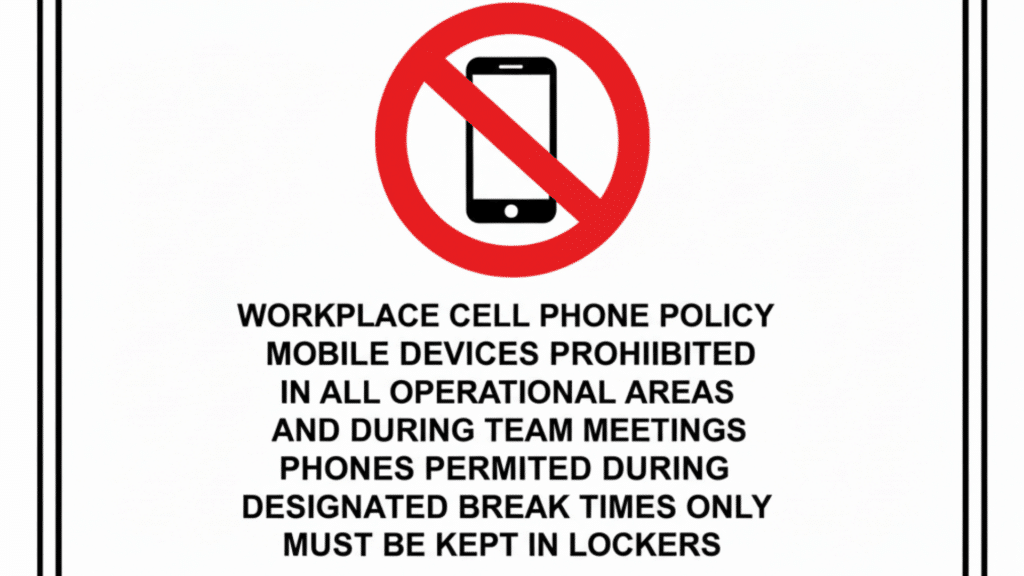
2. Cell Phone Policy – Use only During Scheduled Breaks
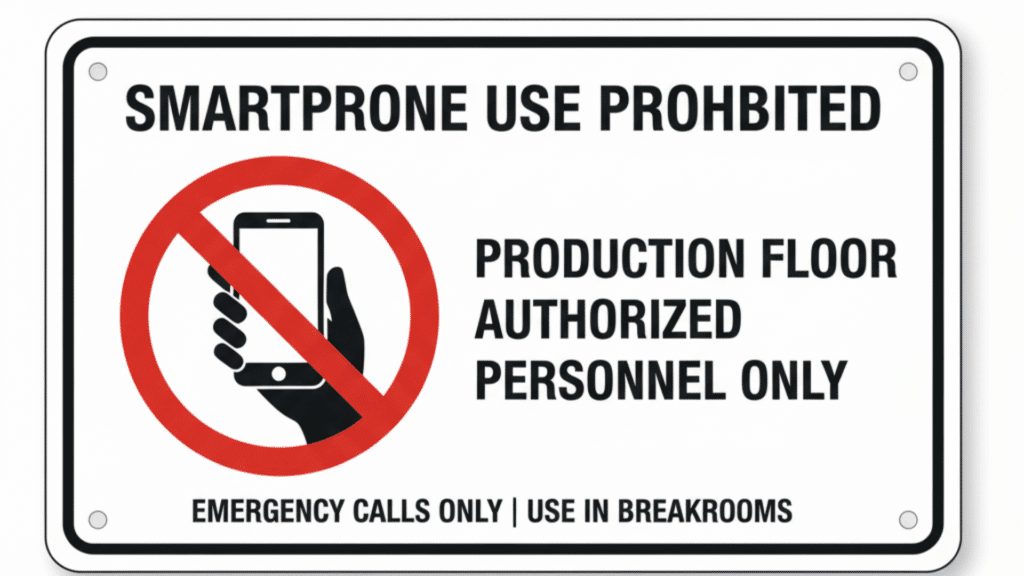
3. Cell Phone Policy – Emphasize Data Protection
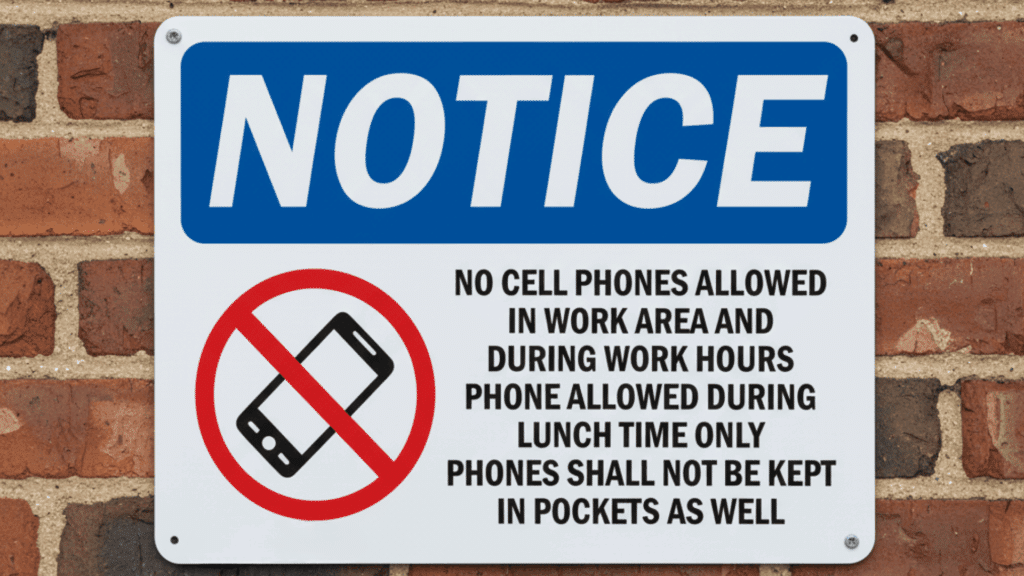
4. Cell Phone Policy – Designate Emergency Use Exceptions
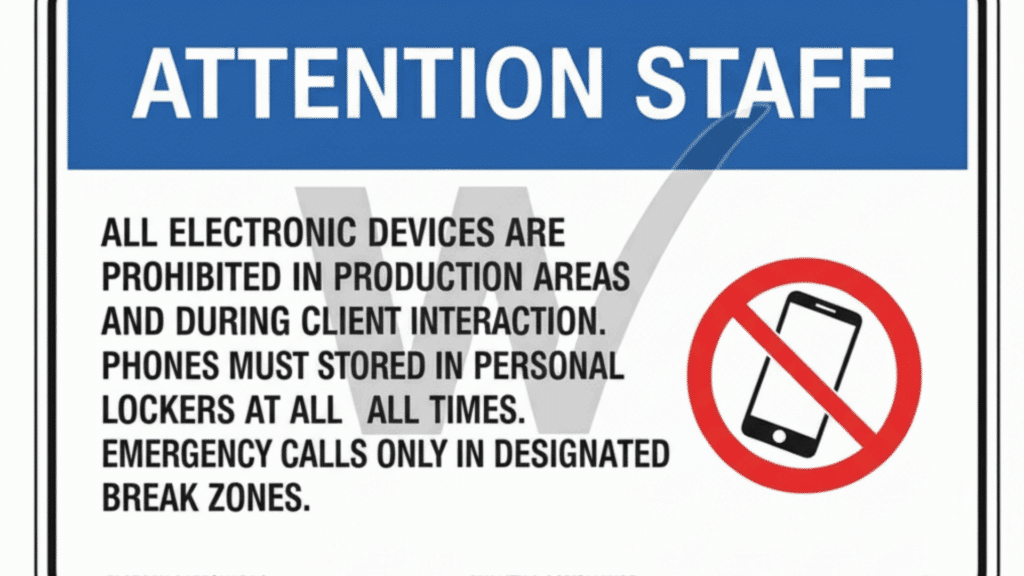
5. Cell Phone Policy – Not Allowed in Kitchen & Dining Area
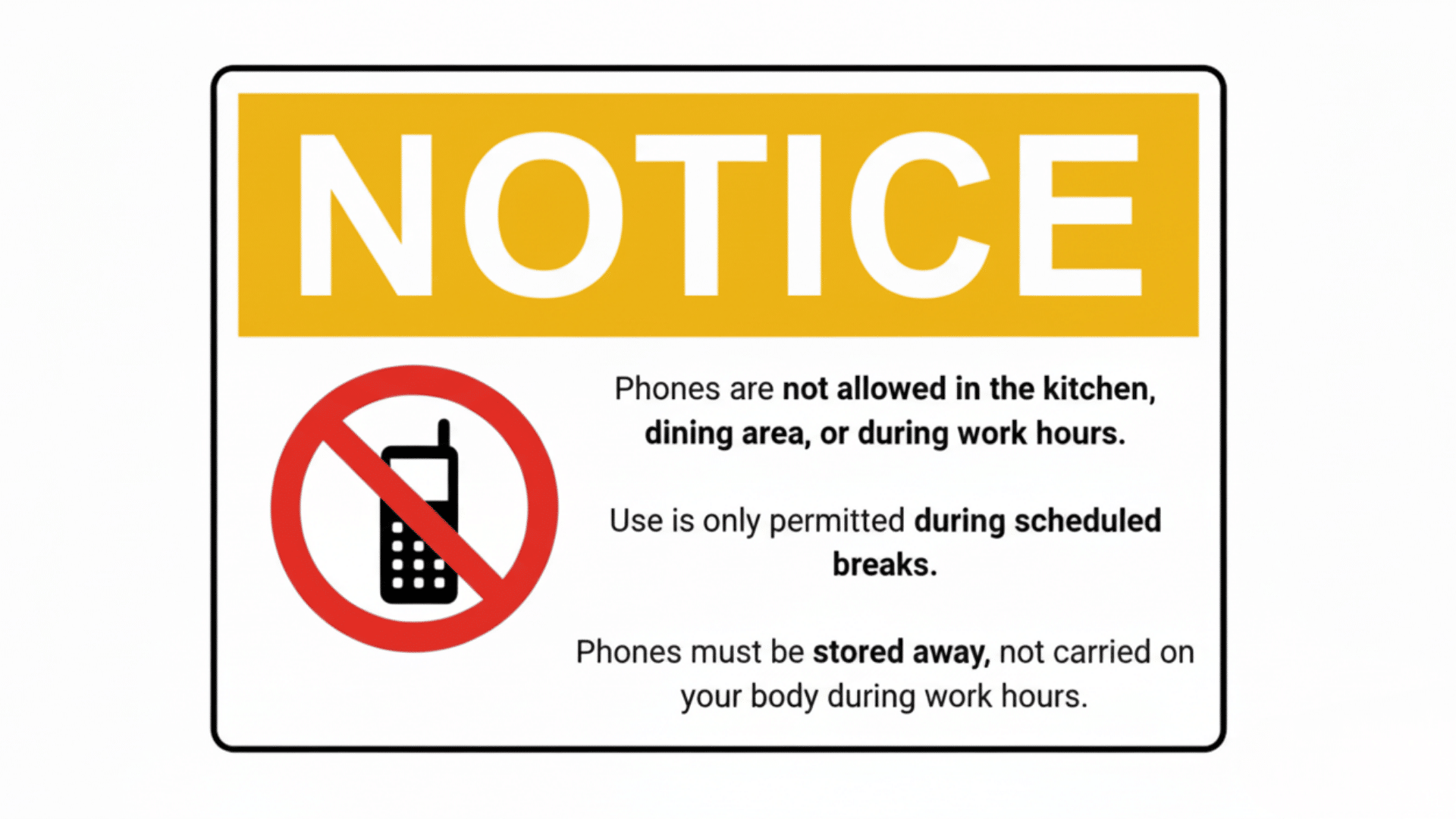
Know how to create an effective fast food job resume that gets you hired. Fast Food Job Resume: Examples & Templates.
Best Practices for Implementing Your Policy
Creating a Cell Phone Policy at Work Is only Half the Battle. Follow These Practices for Successful Implementation.
- Communicate Clearly to All Employees: Include Policy in Employee Handbooks and New Hire Orientation
- Hold Training Sessions – Explain Why the Policy Exists and Provide Real Examples of Acceptable Use
- Enforce Rules Consistently – Apply the Same Standards to All Employees Regardless of Position
- Start with Warnings – Use Progressive Discipline for Violations Rather than Immediate Termination
- Get Employee Feedback – Ask for Input During Policy Creation and Regular Reviews
- Document Everything – Keep Records of Violations and Disciplinary Actions for Legal Protection
Practical Examples from the Workplace
1. abc Manufacturing reduced Workplace Accidents by 40% After Implementing Strict Phone-Free Zones on Factory Floors.
They Installed Phone Lockers at Shift Entrances and Created Clear Emergency Communication Procedures.
2. City Medical Center improved Patient Satisfaction Scores by 25% when Nurses Stopped Using Personal Phones During Rounds.
They Established Family Emergency Protocols and Provided Work Phones for Department Heads.
Common Pitfalls to Avoid
Many Companies Make the Same Mistakes when Creating Their Cell Phone Policies.
Avoid These Five Common Problems to Keep Employees Happy and Your Business Protected.
- Making Rules Too Strict – Overly Harsh Policies Cause Employees to Ignore Them Completely
- Inconsistent Enforcement – Applying Different Standards to Managers and Regular Staff Creates Workplace Conflicts
- Ignoring Legal Requirements – Forgetting State Reimbursement Laws and Privacy Regulations Leads to Costly Violations
- Poor Communication – Not Explaining Why Rules Exist or Using Complicated Language Confuses Employees
- Never Updating Policies – Old Rules Don’t Address New Technology or Changing Workplace Needs
Also learn how to present your achievements effectively with real self-appraisal examples by checking out this blog.
Conclusion
Creating a Cell Phone Policy at Work Protects Your Business While Maintaining Employee Satisfaction.
A Well-Written Policy Reduces Productivity Losses, Prevents Security Breaches, and Avoids Legal Problems.
Use the Templates and Examples Provided to Build Rules that Fit Your Company’s Needs.
Communicate Clearly, Enforce Consistently, and Update Regularly.
Avoid Common Mistakes Like Overly Strict Rules or Inconsistent Enforcement.
Start Building Your Policy Today Using Our Templates and Guidelines.
Download the Resources and Customize Them for Your Business.
Ready to Create Your Cell Phone Policy? Download Our Free Templates and Start Protecting Your Business Today.
Frequently Asked Questions
What Is Phone Etiquette?
Phone Etiquette Refers to Proper Manners and Professional Behavior During Telephone Conversations.
It Includes Speaking Clearly, Listening Actively, and Avoiding Background Noise.
What Is the First Thing you Should Do Before Making a Business Telephone Call?
Plan Your Call by Writing Down Key Points you Need to Discuss.
Gather all necessary documents and choose a quiet location without distractions.

